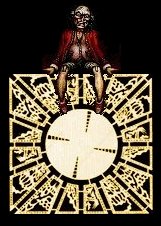PEACEFUL
RAGE
"Circle of Anger"
"The
Sculptor's Treasure"
Art research by Maurizio De Gasperi
Written research by Alexa Black
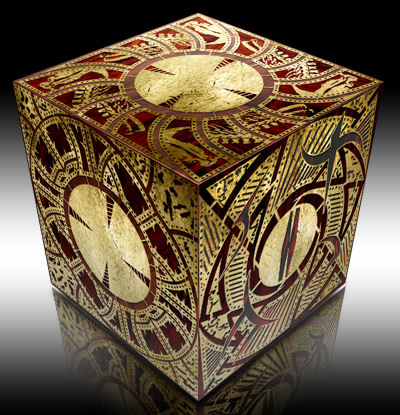
Letter
sent to Pyramid-Gallery - January 17th, 2009
From the studio of Michael Caldwell, painter
Prior to the recent unusual occurrences, the box known as Peaceful Rage - "The Sculptor's Treasure" was believed to be an imitation, created by someone inspired by Lemarchand's style (or simply intrigued by the web of superstition and legend that has grown up around his creations.) I myself am unsure what to make of the reported events; it may simply be that the people involved are fans of the legends themselves, and pulling an elaborate prank.
Rebecca Simmons, the woman to whom these things supposedly happened, was quite intrigued by the box. I consider it possible that the whole thing is an ill-conceived bit of "performance art" on the part of Ms. Simmons and her paramour, especially given that several details of the supposed events do not match up with the usual legends.
Still, I must confess that the whole thing makes me more uneasy than it should. I felt strange from the moment I first saw the box, and I am not normally the superstitious sort. Of late, my premonitions have worsened. I wake from sleep and hear a voice, which sounds like Ms. Simmons', pleading for my aid. It is, of course, entirely possible that this is merely a manifestation of my own disquiet. However, I document it to ease my own mind on this matter.
My description may also prove useful to those interested in Lemarchand's work, as scholars or collectors. As I understand it, it is often difficult to differentiate genuine Lemarchand creations from the imitations that surface now and again. Whether the "Treasure" is the genuine article or not, the things enumerated in this account may later help those interested in determining whether a given box is real or is an imitation.
The unusual thing about this box, and the chief feature that leads me to believe it is a sculpture, an art object by an admirer of Lemarchand's work, is the nature of its transformations. This box, in the intermediate stages of its solution, transforms into stylized representations of recognizable shapes: birds, beasts, even, it is rumored, a person with a screaming mouth. In the art gallery where, until the recent events, it was on display, the box sat in its usual shape. Around it hung diagrams of the more elaborate of its known transformations, with instructions on how to perform them.
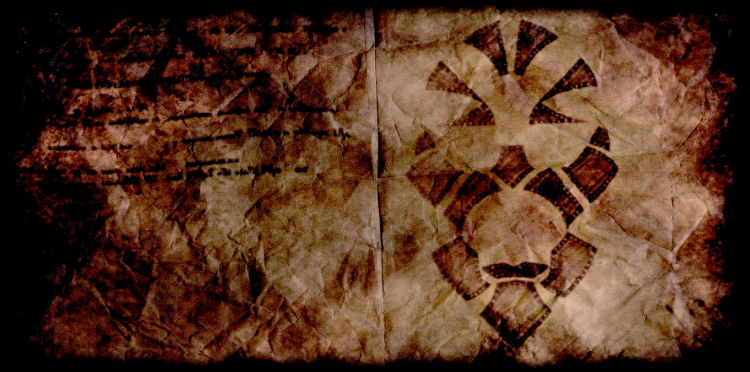
The exhibit also included video footage of hands manipulating it into several of these intermediate stages. The hands were feminine and slender. Supposedly, they were Ms. Simmons' hands, as she helped with the other artist's installation. It is said that while being filmed manipulating the box, she became quite attached to it, even distressed when it was taken away from her. In the words of her lover, Bobby Bryce, this began the obsession that led to the box disappearing days ago.
According to Bryce, it was Simmons herself who stole it. Apparently she believed, from the clues in the installation and her own experience manipulating it, that she knew, or could determine, its solution. She became, from what he tells us, obsessed with it and with the possibility of solving it.
He claims to have found her in the tunnels beneath their apartment complex, having solved it. With her, he saw a creature she later referred to as "The Sculptor." This creature, like many in similar legends, was a mutilated man, its arms skinned but for the flesh of its delicate hands. Its chest bore similar mutilations, skin removed and then stretched and pinned back over it. This skin was decorated with hooks driven through it and symbols carved into it. Bryce also claimed that the color of this skin did not match that of the creature's face or the rest of its body. He suspected that the creature had borrowed it from one of its victims.
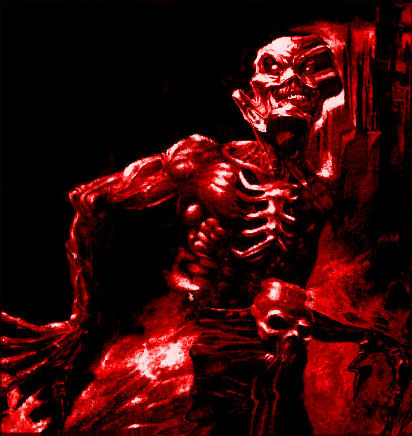
By the time Bryce arrived, the creature had apparently practiced some of its art on Simmons, who had been, in his words, "broken and put back together." Parts of her body had been skinned; her breasts had been removed and repositioned; her bones had been broken and reset at unnatural angles.
Bryce, in terror, hid, attempting to devise a plan to rescue Simmons. He overheard the Sculptor speaking as it "worked." From his description, apparently the creature promised Simmons that, when these "transformations" were complete, she would become a creature like him, performing similar operations upon others and bringing "art and order" to "the chaos of the flesh." Simmons, he says, responded with "ecstatic" cries and professions of gratitude amid her cries of pain.
It should be noted that this exchange is unusual. Depending on the sources one takes to be reliable, such a transformation usually only occurs once the puzzle-solver is taken away and placed in a particular chamber. Whether this is done or not, as I understand the legends, depends on the determination of some higher power, rather than these creatures themselves.
As far as I can determine, this inconsistency means one of several things, in ascending order of likelihood:
1. This particular creature is unusual and endowed with the power to transform its victims into others like itself, and was telling the truth to Ms. Simmons when it made such a promise;
2. The mutilations were a ritual prelude to a later transformation, which would occur once it stole her away to its own realm. These would happen in the usual manner should Simmons be judged "worthy" of them;
3. The creature had limited powers of transformation, and was promising Simmons something other than what it actually provided. Rather, it was transforming her into some lesser creature, a servant or minion or pet;
4. The creature was simply lying, and Simmons was nothing more than a victim it had deceived; or
5. The whole thing is an elaborate hoax on the part of Simmons and Bryce, and here they reveal an error in their understanding of the usual legends, or a careless oversight.
Bryce claims that he waited for a moment when the Sculptor was particularly invested in its task, and its victim particularly distracted by her agonies (or ecstasies), snatched up the box, and, as hurriedly as he could, proceeded to solve it again, seeking to send the Sculptor back from whence it came.

It turned on him, its chisels in its hands, and tried to stop him, but he ran, solving as he went. Ms. Simmons, hobbling from the breaks in her legs, also shambled after him, given some strange strength by these proceedings. As he tells it, the woman -- who formerly had loved him -- cursed him for his interference and promised to slay him herself if he succeeded.
As he tells it, he did. The Sculptor vanished as he restored the box to its usual shape. The thing that had been the object of his affection, however, did not disappear with it. She remained in the tunnels, searching for him. She vowed to make of him something similar to what she had become, only without the "ascension," of which he would "never be worthy." She has, he claims, neither died of her wounds nor disappeared, but remains and continues to hunt him, possessed of strange powers given to her by the Sculptor's half-finished "transformation."
Bryce fled to my house, and told me his tale. I do not know why he chose me, as I am neither well acquainted with him nor with Ms. Simmons. Our art has hung in some of the same galleries, true, but beyond this distant collegiality I have no investment in his fortunes, nor he in mine. If it is a hoax, it may be that the two of them deemed me a good choice to tell, as closer friends might recognize their prank immediately for what it was.
(Or perhaps he goes from house to house, repeating the same behavior, while Rebecca, hidden, films our reactions for some "art installation" later on. The theme of which would no doubt be "the nature of fear," or "Man's gullibility," or something similarly trite.)
I do not know. Bryce pounded on my door in the wee hours three days past, begging shelter off me, and a place to hide. I turned him away. If he is lying, such a practical joke brings only annoyance to me, and distress to my house, despite that I have for three years now been the only one living in it. Doubly so if part of the plan is for Simmons herself to show up next, banging on my door some other midnight looking for Bryce.
And if by some black miracle Bryce's tale is true, it would be still better to keep myself uninvolved. Though I do not believe it, strange dreams or no. This house is old; things will creak and winds will howl, now and again. I send this off to your archives, as I mentioned, as an item of interest and a demonstration of the lengths to which some fools will go for notoriety when their art itself is mediocre.
I send this on to you and other scholars of Lemarchand and his works, to make of it what you will.
I hope it may prove of some use to you.
Michael Caldwell, painter
From the studio of Michael Caldwell, painter
Prior to the recent unusual occurrences, the box known as Peaceful Rage - "The Sculptor's Treasure" was believed to be an imitation, created by someone inspired by Lemarchand's style (or simply intrigued by the web of superstition and legend that has grown up around his creations.) I myself am unsure what to make of the reported events; it may simply be that the people involved are fans of the legends themselves, and pulling an elaborate prank.
Rebecca Simmons, the woman to whom these things supposedly happened, was quite intrigued by the box. I consider it possible that the whole thing is an ill-conceived bit of "performance art" on the part of Ms. Simmons and her paramour, especially given that several details of the supposed events do not match up with the usual legends.
Still, I must confess that the whole thing makes me more uneasy than it should. I felt strange from the moment I first saw the box, and I am not normally the superstitious sort. Of late, my premonitions have worsened. I wake from sleep and hear a voice, which sounds like Ms. Simmons', pleading for my aid. It is, of course, entirely possible that this is merely a manifestation of my own disquiet. However, I document it to ease my own mind on this matter.
My description may also prove useful to those interested in Lemarchand's work, as scholars or collectors. As I understand it, it is often difficult to differentiate genuine Lemarchand creations from the imitations that surface now and again. Whether the "Treasure" is the genuine article or not, the things enumerated in this account may later help those interested in determining whether a given box is real or is an imitation.
The unusual thing about this box, and the chief feature that leads me to believe it is a sculpture, an art object by an admirer of Lemarchand's work, is the nature of its transformations. This box, in the intermediate stages of its solution, transforms into stylized representations of recognizable shapes: birds, beasts, even, it is rumored, a person with a screaming mouth. In the art gallery where, until the recent events, it was on display, the box sat in its usual shape. Around it hung diagrams of the more elaborate of its known transformations, with instructions on how to perform them.

The exhibit also included video footage of hands manipulating it into several of these intermediate stages. The hands were feminine and slender. Supposedly, they were Ms. Simmons' hands, as she helped with the other artist's installation. It is said that while being filmed manipulating the box, she became quite attached to it, even distressed when it was taken away from her. In the words of her lover, Bobby Bryce, this began the obsession that led to the box disappearing days ago.
According to Bryce, it was Simmons herself who stole it. Apparently she believed, from the clues in the installation and her own experience manipulating it, that she knew, or could determine, its solution. She became, from what he tells us, obsessed with it and with the possibility of solving it.
He claims to have found her in the tunnels beneath their apartment complex, having solved it. With her, he saw a creature she later referred to as "The Sculptor." This creature, like many in similar legends, was a mutilated man, its arms skinned but for the flesh of its delicate hands. Its chest bore similar mutilations, skin removed and then stretched and pinned back over it. This skin was decorated with hooks driven through it and symbols carved into it. Bryce also claimed that the color of this skin did not match that of the creature's face or the rest of its body. He suspected that the creature had borrowed it from one of its victims.

By the time Bryce arrived, the creature had apparently practiced some of its art on Simmons, who had been, in his words, "broken and put back together." Parts of her body had been skinned; her breasts had been removed and repositioned; her bones had been broken and reset at unnatural angles.
Bryce, in terror, hid, attempting to devise a plan to rescue Simmons. He overheard the Sculptor speaking as it "worked." From his description, apparently the creature promised Simmons that, when these "transformations" were complete, she would become a creature like him, performing similar operations upon others and bringing "art and order" to "the chaos of the flesh." Simmons, he says, responded with "ecstatic" cries and professions of gratitude amid her cries of pain.
It should be noted that this exchange is unusual. Depending on the sources one takes to be reliable, such a transformation usually only occurs once the puzzle-solver is taken away and placed in a particular chamber. Whether this is done or not, as I understand the legends, depends on the determination of some higher power, rather than these creatures themselves.
As far as I can determine, this inconsistency means one of several things, in ascending order of likelihood:
1. This particular creature is unusual and endowed with the power to transform its victims into others like itself, and was telling the truth to Ms. Simmons when it made such a promise;
2. The mutilations were a ritual prelude to a later transformation, which would occur once it stole her away to its own realm. These would happen in the usual manner should Simmons be judged "worthy" of them;
3. The creature had limited powers of transformation, and was promising Simmons something other than what it actually provided. Rather, it was transforming her into some lesser creature, a servant or minion or pet;
4. The creature was simply lying, and Simmons was nothing more than a victim it had deceived; or
5. The whole thing is an elaborate hoax on the part of Simmons and Bryce, and here they reveal an error in their understanding of the usual legends, or a careless oversight.
Bryce claims that he waited for a moment when the Sculptor was particularly invested in its task, and its victim particularly distracted by her agonies (or ecstasies), snatched up the box, and, as hurriedly as he could, proceeded to solve it again, seeking to send the Sculptor back from whence it came.

It turned on him, its chisels in its hands, and tried to stop him, but he ran, solving as he went. Ms. Simmons, hobbling from the breaks in her legs, also shambled after him, given some strange strength by these proceedings. As he tells it, the woman -- who formerly had loved him -- cursed him for his interference and promised to slay him herself if he succeeded.
As he tells it, he did. The Sculptor vanished as he restored the box to its usual shape. The thing that had been the object of his affection, however, did not disappear with it. She remained in the tunnels, searching for him. She vowed to make of him something similar to what she had become, only without the "ascension," of which he would "never be worthy." She has, he claims, neither died of her wounds nor disappeared, but remains and continues to hunt him, possessed of strange powers given to her by the Sculptor's half-finished "transformation."
Bryce fled to my house, and told me his tale. I do not know why he chose me, as I am neither well acquainted with him nor with Ms. Simmons. Our art has hung in some of the same galleries, true, but beyond this distant collegiality I have no investment in his fortunes, nor he in mine. If it is a hoax, it may be that the two of them deemed me a good choice to tell, as closer friends might recognize their prank immediately for what it was.
(Or perhaps he goes from house to house, repeating the same behavior, while Rebecca, hidden, films our reactions for some "art installation" later on. The theme of which would no doubt be "the nature of fear," or "Man's gullibility," or something similarly trite.)
I do not know. Bryce pounded on my door in the wee hours three days past, begging shelter off me, and a place to hide. I turned him away. If he is lying, such a practical joke brings only annoyance to me, and distress to my house, despite that I have for three years now been the only one living in it. Doubly so if part of the plan is for Simmons herself to show up next, banging on my door some other midnight looking for Bryce.
And if by some black miracle Bryce's tale is true, it would be still better to keep myself uninvolved. Though I do not believe it, strange dreams or no. This house is old; things will creak and winds will howl, now and again. I send this off to your archives, as I mentioned, as an item of interest and a demonstration of the lengths to which some fools will go for notoriety when their art itself is mediocre.
I send this on to you and other scholars of Lemarchand and his works, to make of it what you will.
I hope it may prove of some use to you.
Michael Caldwell, painter
Three Months Later:
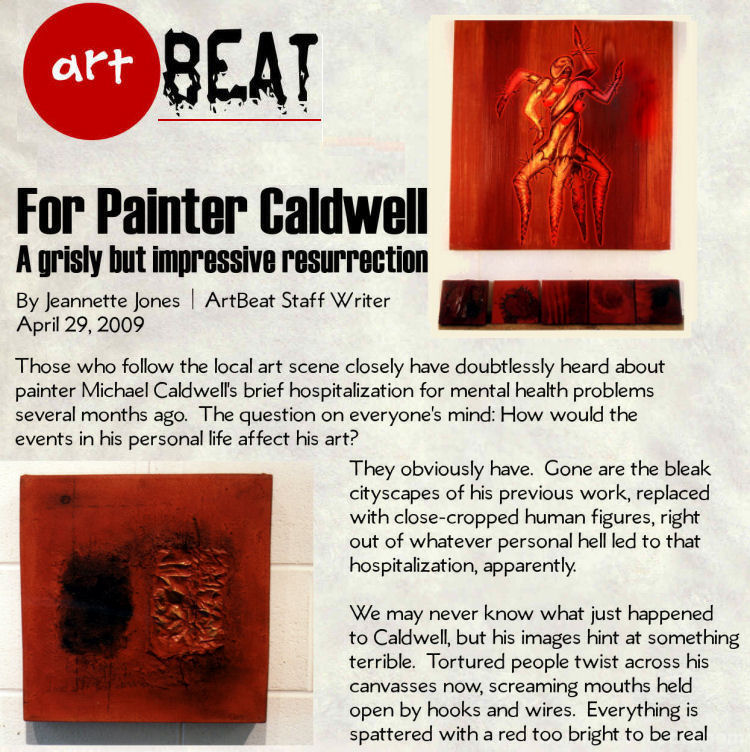
Those
that
follow the local art scene closely have doubtlessly heard about painter
Michael Caldwell's brief hospitalization for mental health problems
several months ago. The question on everyone's mind: How
would
the events in his personal life affect his art?
They obviously have. Gone are the bleak cityscapes of his previous work, replaced with close-cropped human figures. Figures right out of whatever personal hell led to that hospitalization, apparently.
We may never know just what happened to Caldwell, but his images hint at something terrible. Tortured people twist across his canvasses now, screaming mouths held open by hooks and wires. Everything is spattered with a red too bright to be real blood, somehow all the more startling for its vividness. Fans of Goya or Bosch would surely like this stuff.
The paintings are arranged meticulously around an enormous canvas at the center, a ten-foot-tall painting of a disfigured women, her arms and legs jutting from her body at strange angles, her breasts seemingly sewn onto her flesh. And everywhere, the brightly painted blood: slashes and cuts and wounds held open with metal wires and staples.
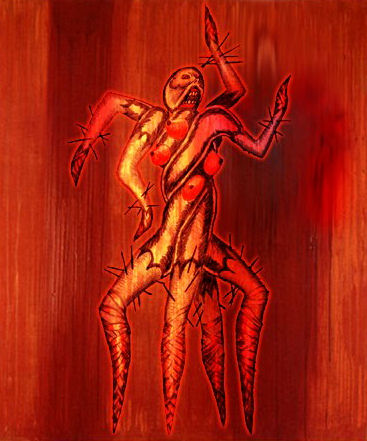
Entitled "Rebecca, Unfinished," the painting is the truly unsettling crown jewel of a brilliantly macabre collection. The title is assumed to be a reference to the disappearance of another local artist, Rebecca Simmons, earlier this year. Perhaps the psychic distress that so affected Caldwell related to the disappearance of Simmons in some way.
Or perhaps the depiction of Simmons here is some sort of metaphor, though these images lack Caldwell's usual subtlety. He had a knack for capturing, in soft shadowy blues, the loneliness of an empty street at night.
To put it bluntly: there is nothing subtle about someone screaming while trying to hold in his guts.
As disturbing as these images are, though, they're truly inspired. Even admirers of Caldwell's work had noticed the artist seeming to get stuck in a rut. How many nighttime cityscapes can one paint before they all begin to look the same? Clearly, his recent experiences, however unsettling have invigorated him anew as an artist.
But is it worth seeing? Some fans of Caldwell will undoubtedly dislike this exhibit, either because the graphically violent content offends them or because the abrupt shift in style and subject is not to their taste.
However, those who can tolerate the gore and either don't know the "old" Caldwell or aren't wedded to his older style will find this exhibit a rare, albeit chilling, treat. The work has its own frenetic energy, seizing the attention of those who look at it, and staying in their minds long after they're gone home.
Whether this is a good thing or a bad thing depends on how interested the viewer is in one talented painter's personal hell.
They obviously have. Gone are the bleak cityscapes of his previous work, replaced with close-cropped human figures. Figures right out of whatever personal hell led to that hospitalization, apparently.
We may never know just what happened to Caldwell, but his images hint at something terrible. Tortured people twist across his canvasses now, screaming mouths held open by hooks and wires. Everything is spattered with a red too bright to be real blood, somehow all the more startling for its vividness. Fans of Goya or Bosch would surely like this stuff.
The paintings are arranged meticulously around an enormous canvas at the center, a ten-foot-tall painting of a disfigured women, her arms and legs jutting from her body at strange angles, her breasts seemingly sewn onto her flesh. And everywhere, the brightly painted blood: slashes and cuts and wounds held open with metal wires and staples.

Entitled "Rebecca, Unfinished," the painting is the truly unsettling crown jewel of a brilliantly macabre collection. The title is assumed to be a reference to the disappearance of another local artist, Rebecca Simmons, earlier this year. Perhaps the psychic distress that so affected Caldwell related to the disappearance of Simmons in some way.
Or perhaps the depiction of Simmons here is some sort of metaphor, though these images lack Caldwell's usual subtlety. He had a knack for capturing, in soft shadowy blues, the loneliness of an empty street at night.
To put it bluntly: there is nothing subtle about someone screaming while trying to hold in his guts.
As disturbing as these images are, though, they're truly inspired. Even admirers of Caldwell's work had noticed the artist seeming to get stuck in a rut. How many nighttime cityscapes can one paint before they all begin to look the same? Clearly, his recent experiences, however unsettling have invigorated him anew as an artist.
But is it worth seeing? Some fans of Caldwell will undoubtedly dislike this exhibit, either because the graphically violent content offends them or because the abrupt shift in style and subject is not to their taste.
However, those who can tolerate the gore and either don't know the "old" Caldwell or aren't wedded to his older style will find this exhibit a rare, albeit chilling, treat. The work has its own frenetic energy, seizing the attention of those who look at it, and staying in their minds long after they're gone home.
Whether this is a good thing or a bad thing depends on how interested the viewer is in one talented painter's personal hell.
